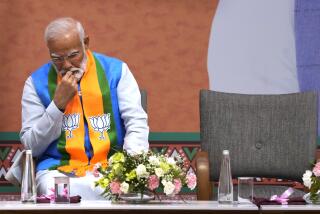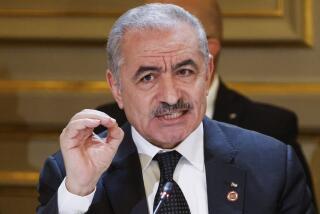India’s Tottering Government Falls
- Share via
NEW DELHI — India’s fourth government in two years collapsed Friday night, ending a shaky, short-lived coalition and heralding a new period of political chaos.
Prime Minister Inder Kumar Gujral resigned and his United Front government fell after the Congress (I) Party, a key ally of his coalition, withdrew its support.
Gujral lasted seven months. His government had been tottering for weeks, since an investigation into the 1991 assassination of Prime Minister Rajiv Gandhi revealed that one of the parties in Gujral’s coalition had links to Gandhi’s killers.
It was not immediately clear whether any party could patch together enough support in India’s Parliament to form a new government--or whether fresh elections are on the way.
Analysts said possible outcomes include a sharp curtailing of India’s 6-year-old effort to dismantle its socialist economy and the ascension of a Hindu nationalist party with a history of exacerbating Hindu-Muslim tensions.
Yet the most likely scenario, they said, is a continuation of what the country got under Gujral: a weak, unstable government unable to gain enough support to act decisively.
“The political system is in total disarray,” said Bhabani Sengupta, director of the Center for Studies in Global Issues, a New Delhi think tank. “Governments are collapsing because none of the parties can manage to work together.”
No party now has a majority in India’s lower house of Parliament, the 545-seat Lok Sabha. Power is divided roughly among the Congress Party, the Bharatiya Janata Party, or BJP, and the parties that make up the United Front.
The Congress Party had demanded that Gujral drop one of the members of his 14-party coalition, the Dravidian Progressive Federation, or DMK, which a recent investigation linked to the Liberation Tigers of Tamil Eelam guerrillas who murdered Gandhi in 1991.
The Tamils, an ethnic group in southern India and Sri Lanka, have been fighting a guerrilla war for independence in Sri Lanka since the early 1980s.
Gujral, a deliberative man with a reputation for uprightness, said he believes that the evidence against the DMK was thin. He would not budge, and the Congress Party pulled the props out from under his government.
“The Congress Party has not allowed the Parliament to function,” Gujral wrote in his resignation letter.
Gujral’s resignation capped weeks of sometimes uproarious political infighting as the crisis fueled by his weakening leadership spread throughout the country.
In a dispute in the state parliament of Uttar Pradesh in October, rival politicians beat, bloodied and threw furniture at one another before millions of television viewers.
One prominent paper, the Pioneer, accused India’s elected officials of embarrassing the country just as world leaders such as President Clinton and Russian President Boris N. Yeltsin were preparing to visit.
“Our politicians, like frogs in a well, seem to have no concern with the nation’s image outside their own myopic vision,” a Pioneer editorial writer wrote.
The turmoil seems unlikely to end soon.
Under India’s parliamentary system, Gujral’s resignation means the president, Kocheril Raman Narayanan, must choose one of two paths: He must either decide whether to ask one of the country’s main political parties to try to form a government, or ask the country’s 498 million voters to go to the polls.
Narayanan appeared likely to ask the Congress Party to form a government. The Congress Party has governed India for all but a few of the 50 years since its independence from Britain. Several spectacular corruption scandals in recent years have smudged its reputation.
As the fortunes of the Congress Party have sagged, no party has risen to take its place. The result has been political stalemate.
A leader of the Congress Party said Friday night that he was confident his party could put together a working majority in the Parliament. He said the party’s first task would be to jump-start the country’s economy, whose growth has slowed after a five-year burst.
“Our first priority would be to put the economy back on rails and revive what we started in 1991,” said Oscar Fernandez, general secretary of the Congress Party.
Waiting eagerly on the sidelines is the BJP, a Hindu nationalist party that held power briefly last year.
Some analysts say the BJP would win a nationwide election. The BJP has threatened to reverse India’s economic liberalization.
BJP General Secretary Sushma Swaraj said that if his party won, it would examine the practices of multinational corporations investing in India.
“Only after a thorough review would they be allowed to stay here,” she said.
Amitabh Sharma of The Times’ New Delhi Bureau contributed to this report.
(BEGIN TEXT OF INFOBOX / INFOGRAPHIC)
Collapsing Coalition
A look at Indian governments since May 1996 elections that left no party with a firm grip on power:
1996
May 7: Last day of voting in parliamentary elections that leave the Hindu nationalist Bharatiya Janata Party, the Congress (I) Party and the United Front coalition of leftist and regional parties without a clear majority in the 545-member lower house.
May 16: BJP leader Atal Behari Vajpayee is sworn in as prime minister and given two weeks to prove himself before a vote of confidence.
May 28: The BJP, vilified as anti-Muslim, resigns before vote of confidence that it was poised to lose.
June 1: United Front leader H.D. Deve Gowda, whose Congress-backed coalition embraced 14 parties, is sworn in as prime minister.
****
1997
March 30: Accusing Gowda of poor leadership, Congress Party withdraws support from United Front and calls on Gowda to step down.
April 11: Gowda loses vote of confidence and resigns.
April 21: Inder Kumar Gujral is sworn in as prime minister.
Nov. 28: Congress Party withdraws support from Gujral, ensuring the collapse of his administration, after a dispute over the makeup of the United Front.
Source: Associated Press
More to Read
Sign up for Essential California
The most important California stories and recommendations in your inbox every morning.
You may occasionally receive promotional content from the Los Angeles Times.













